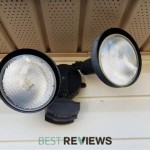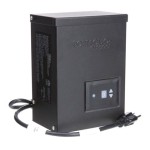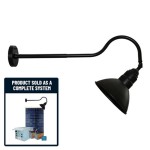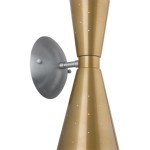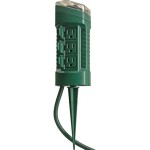Outdoor Icicle Lights Not Working: Troubleshooting and Solutions
Outdoor icicle lights, with their cascading, dripping aesthetic, are a popular choice for holiday decorations and year-round ambient lighting. However, the joy of illuminating a home or garden with these lights can quickly turn to frustration when they malfunction. Diagnosing and resolving issues with outdoor icicle lights requires a systematic approach, focusing on common problem areas and potential solutions. This article provides a comprehensive guide to troubleshooting icicle light failures, offering practical advice to restore their functionality and extend their lifespan.
Power Source and Connections: The Foundation of Functionality
The first and most crucial step in troubleshooting any electrical device is to verify the power source and the integrity of the connections. This holds particularly true for outdoor icicle lights, which are frequently exposed to harsh weather conditions that can compromise their performance. Begin by examining the outlet into which the lights are plugged.
Confirm that the outlet is functioning correctly. Use a voltage tester or plug another electrical device into the same outlet to verify that it is receiving power. If the outlet is dead, check the circuit breaker or fuse box associated with that outlet. A tripped breaker or blown fuse is a common cause of power interruption. Reset the breaker or replace the fuse if necessary. If the breaker trips repeatedly or the fuse blows again shortly after replacement, there may be a more serious electrical issue that requires professional attention. Do not attempt to repeatedly reset the breaker or replace the fuse without investigating the underlying cause, as this could pose a fire hazard.
Next, visually inspect the power cord of the icicle lights. Look for any signs of damage, such as cuts, abrasions, or exposed wires. Outdoor environments can take a toll on electrical cords, and even minor damage can lead to a short circuit or power failure. If the cord is damaged, it should be replaced or repaired by a qualified electrician. Attempting to repair a damaged cord without proper knowledge and tools can be dangerous. Furthermore, ensure the cord is securely plugged into the outlet. A loose connection can cause intermittent power issues or prevent the lights from working altogether. If using an extension cord, ensure it is specifically designed for outdoor use and is rated to handle the power load of the icicle lights. Inspect the extension cord for damage as well.
Pay attention to any connections between sections of icicle lights if they are designed to be connected in a series. These connections are often vulnerable to moisture and corrosion, which can disrupt the electrical circuit. Disconnect the sections and examine the connectors for signs of corrosion or damage. Clean corroded connectors with a wire brush or a specialized electrical contact cleaner. Ensure that the connectors are properly aligned and securely fastened when reconnecting the sections. If the connectors are severely damaged, they may need to be replaced.
Consider the use of a Ground Fault Circuit Interrupter (GFCI) outlet, especially in damp or wet locations. GFCI outlets are designed to detect ground faults and quickly cut off power, reducing the risk of electrical shock. If the icicle lights are plugged into a GFCI outlet and the outlet trips, it could indicate a ground fault in the lights or the wiring. Inspect the lights for any signs of water damage or exposed wires, and address the issue accordingly. A GFCI outlet is an important safety feature for outdoor electrical applications.
Bulb and Component Inspection: Identifying the Point of Failure
Once the power source and connections have been verified, the next step is to meticulously inspect the individual bulbs and other components of the icicle lights. A single malfunctioning bulb or component can sometimes disrupt the entire string, especially in series circuits.
Begin by visually inspecting each bulb. Look for any signs of damage, such as cracks, breaks, or discoloration. If any bulbs appear damaged, replace them immediately. Ensure that the replacement bulbs are of the correct voltage and wattage rating for the icicle lights. Using the wrong type of bulb can damage the lights or create a fire hazard. Bulbs may loosen over time with vibrations and exposure to the elements. Make sure each bulb is properly tightened into its socket. For LED icicle lights, while less frequent, LEDs themselves can fail. This may be indicated by a noticeably dimmer light or a complete lack of illumination from that specific LED.
If the icicle lights have fuses, locate the fuse compartment and inspect the fuse. A blown fuse indicates an overcurrent or short circuit in the lights. Replace the fuse with a new fuse of the same amperage rating. If the new fuse blows immediately or shortly after replacement, there is likely a more serious electrical problem that requires further investigation. Do not attempt to bypass the fuse or use a fuse with a higher amperage rating, as this could create a fire hazard. Fuses are designed to protect the circuit from overloads, and bypassing them can compromise safety.
Many icicle lights utilize miniature shunt resistors or similar mechanisms within the bulb sockets to maintain circuit continuity if a bulb fails. If a bulb burns out and is not promptly replaced, the shunt resistor may fail, further disrupting the circuit. If replacing the bulbs does not resolve the issue, inspect the bulb sockets for any signs of corrosion or damage. Clean corroded sockets with a wire brush or electrical contact cleaner. If the sockets are severely damaged, they may need to be replaced. Replacing the entire string of lights might be the most practical solution in this situation.
For LED icicle lights, examine the wiring and connections to the LEDs themselves. Look for any signs of damage or corrosion. LED strings often use thin wires and delicate connections, which can be susceptible to damage from bending, twisting, or exposure to the elements. If you find any damaged wires or connections, attempt to repair them with electrical tape or wire connectors. However, if the damage is extensive, replacing the entire string of lights may be the most reliable solution.
Environmental Factors and Maintenance: Preventing Future Issues
Environmental factors play a significant role in the lifespan and functionality of outdoor icicle lights. Proper maintenance and preventative measures can help to mitigate the effects of these factors and prolong the life of the lights.
Water is a major enemy of electrical devices, including icicle lights. Ensure that all connections and components are adequately protected from moisture. Use weatherproof connectors and electrical tape to seal any exposed wires or connections. Consider applying a dielectric grease to connectors to prevent corrosion and moisture ingress. During periods of heavy rain or snow, consider temporarily removing the lights to prevent water damage. Regularly inspect the lights for any signs of water intrusion, such as condensation inside the bulbs or corrosion on the connectors. Address any water intrusion issues promptly to prevent further damage.
Exposure to sunlight can also degrade the plastic and rubber components of icicle lights over time. Consider using lights with UV-resistant materials, especially in areas with intense sunlight. Store the lights in a cool, dry place during the off-season to protect them from sunlight and extreme temperatures. Ensure the storage location is also free from pests that may chew on the wires.
Physical stress can also damage icicle lights. Avoid pulling or tugging on the lights when installing or removing them. Use proper clips or fasteners to secure the lights to prevent them from swaying in the wind or being damaged by falling debris. Periodically inspect the mounting hardware to ensure that it is secure and that the lights are not rubbing against any sharp edges or surfaces. When storing the lights, coil them loosely to avoid creating kinks or stress points in the wires. Consider using a storage reel to keep the lights organized and prevent tangling.
Regular cleaning can also help to extend the life of icicle lights. Use a soft cloth or brush to remove any dirt, dust, or debris from the lights. Avoid using harsh chemicals or abrasive cleaners, as these can damage the plastic and rubber components. Before cleaning, ensure that the lights are unplugged and that all connections are dry. Cleaning helps to prevent corrosion and improve the overall appearance of the lights.
Consider investing in high-quality icicle lights from reputable manufacturers. While these lights may be more expensive initially, they are often more durable and resistant to environmental factors. Look for lights with weatherproof ratings and warranties. Reading product reviews and comparing features can help you choose the right lights for your specific needs.

Outdoor Lights White S

How To Hang Lights On Your Home Balsam Hill
Icicle Lights

Snowing 960 White Led Icicle Light With Clear Cable Diy At B Q

Pick The Right Lights For Your Home Lowe S

Sdjma Icicle Lights With Ice Cone Outdoor Dripping Light 11 5 Ft 96 Led 8 Modes Clear Wire Curtain Indoor Xmas Holiday Wedding Party Decor White Com

Cool White Icicle Lights 720 Led 60ft Connectable Ollny

How To Hang Lights The Right Way

Icicle Lights

240 Warm White Snowing Icicle Timer Lights
Related Posts
